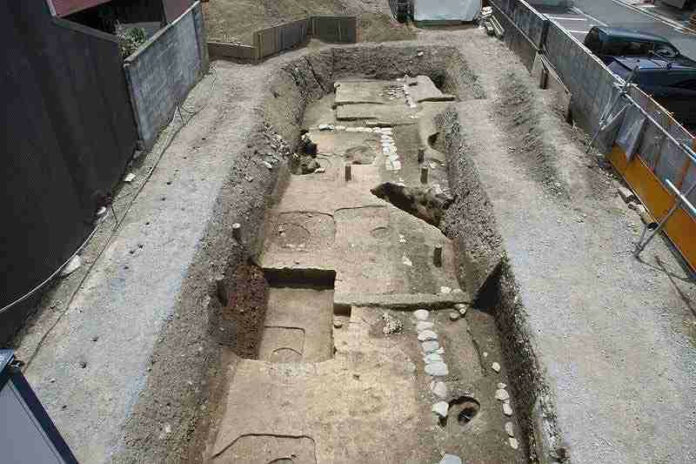In a groundbreaking archaeological discovery, the remains of what is believed to be a dwelling for the empress at the Japanese imperial family’s official residence have been unearthed in Kyoto, Japan’s ancient capital. The findings, which include postholes and other remnants, offer a captivating glimpse into the history of the Japanese imperial family, Heian-kyo (the administrative center of the Heian period), and the cultural exchanges between Japan and China during this era.

The Tokaden Pavilion: Home to the Empress and Female Attendants
The archaeological remains are thought to belong to the Tokaden pavilion, a structure that served as a residence for the empress and female palace attendants. This pavilion is mentioned in notable works of Heian literature, such as “The Tale of Genji” and “The Pillow Book.” The Heian period, spanning from 794 to 1185, saw Heian-kyo (present-day Kyoto) as the emperor’s official residence.
Excavation Findings
Postholes and Their Significance
During the 2015 excavation conducted by the Kyoto City Archaeological Research Institute, five postholes were discovered in the northwest part of the residence, where the Tokaden and Kokiden pavilions were believed to be located. These holes, ranging from 1.2 to 1.5 meters in diameter and arranged from north to south with distances of approximately 3 to 2.1 meters between them, suggest that pillars were buried directly into the ground without the use of foundation stones.
Confirming the Location: Edo Period Documents
To verify the precise positioning of the postholes, researchers consulted a document from the Edo period (1603-1867) that detailed the layout of the palace buildings. The findings aligned with the positions of the holes, confirming that they were part of the southwest section of the Tokaden pavilion, which extended about 12 meters from west to east and about 27 meters from north to south.
Stone Ditches and Foundation Stones

In addition to the postholes, an L-shaped ditch formed by an arrangement of stones was found in the southwest corner of the Tokaden. This ditch, used to channel rainwater from the roof, was similar to another discovered in the northern part of the Kokiden pavilion. A foundation stone between these stone ditches suggests the presence of a corridor connecting the two structures. These stone ditches and foundation stones date back to the 10th century or later, indicating that they were part of a reconstruction after the original building was established without foundation stones.
Cultural Influences and Building Techniques

Emperor Kanmu, who established Japan’s capital at Heian-kyo in 794, greatly admired the culture of the Tang Dynasty in China. Researchers believe that major buildings of the time were constructed by placing pillars on foundation stones, a method imported from China. However, the investigation at the site reveals that, in some cases, the traditional Japanese method of not using foundation stones was also employed in Heian-kyo.
Conclusion
The discovery of these remarkable postholes and archaeological remains is of great significance, providing valuable insights into the history of Kyoto and Japan. A representative from the research institute emphasized the importance of this find, stating, “There is great significance in finding remains from a building from the time of the establishment of the ancient capital in Kyoto. This is first-class material.” The remains have been carefully preserved, ensuring that this new chapter in the rich history of Kyoto and Japan will be cherished for generations to come.

